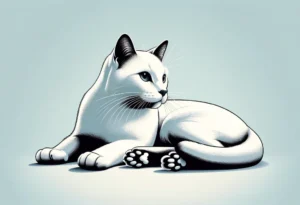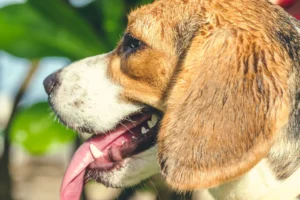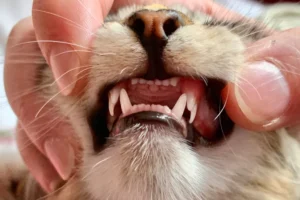Cats are fascinating creatures with many unique traits, one of which includes their sharp, pointed teeth that resemble those of a vampire. Have you ever wondered why cats have these vampire-like teeth? Let’s explore the reasons behind this intriguing feature.
Cats’ Teeth: Unveiling the Mystery
Evolution of Cat Teeth
Cats’ teeth have evolved over millions of years to adapt to their predatory lifestyle. One of the key aspects of their dental evolution is the development of sharp canines, often referred to as “vampire teeth” due to their resemblance to those of mythical blood-sucking creatures.
These sharp canines are essential for cats to effectively catch and kill their prey. They are crucial for holding onto struggling animals, piercing through tough skin and flesh, and delivering a lethal bite. Cats’ ancestors needed these teeth to survive in the wild, and even though domestic cats may not hunt for food, they still retain this feature as a remnant of their evolutionary past.
Interestingly, the positioning and shape of these vampire teeth are also a result of evolution. Unlike humans, cats have what is known as a “heterodont dentition,” meaning their teeth are specialized for different purposes. Their canines are elongated and sharp, while their molars are designed for grinding and slicing. This specialized dental setup allows cats to efficiently consume their prey.
Functionality of Vampire Teeth
Cats’ vampire teeth serve a crucial purpose in their daily lives beyond just hunting. These sharp canines are also used for grooming, defense, and even communication.
When grooming, cats use their vampire teeth to remove dirt, debris, and loose fur from their coat. They carefully lick their coat and then use their teeth to remove any stubborn particles, keeping themselves clean and well-groomed.
In terms of defense, a cat’s vampire teeth are their primary weapons in a hostile situation. If threatened or feeling cornered, a cat may bare its teeth as a warning signal to potential aggressors. The sight of those sharp canines is often enough to deter any potential threat and protect the cat from harm.
Additionally, cats use their vampire teeth in social interactions with other cats. During playtime or establishing dominance, cats may gently bite each other as a form of communication. This behavior, known as “play biting,” is a way for cats to engage with each other and express various emotions.
Overall, the evolution of cat teeth, particularly their vampire teeth, has played a significant role in shaping how these fascinating animals interact with their environment and each other. Their sharp canines are not only a tool for survival but also a means of communication and self-care in their daily lives.
Cat Behavior and Teeth
Did you know that a cat’s vampire teeth, also known as their canine teeth, play a crucial role in their behavior? These sharp teeth are not just for show – they are essential tools that help cats communicate, defend themselves, and hunt for prey. When a cat feels threatened or agitated, they may bare their vampire teeth as a warning sign to others to back off. In grooming rituals, cats often use their teeth to clean themselves and their fellow feline friends. Additionally, during playtime, these teeth come in handy for grabbing toys and wrestling with their companions.
Dental Care for Cats
Taking care of your furry friend’s vampire teeth is vital for their overall health and well-being. Just like humans, cats need regular dental check-ups to ensure their teeth are in top condition. Neglecting their dental hygiene can lead to serious issues like gum disease, tooth decay, and pain. To maintain healthy vampire teeth, consider incorporating dental treats, toys, or even brushing their teeth into their routine. Remember, a happy cat with healthy teeth equals a happy pet parent!
Dental Care Tips for Cats: 1. Schedule regular dental check-ups with your veterinarian to monitor your cat’s oral health. 2. Provide dental treats or toys specifically designed to help clean your cat’s teeth. 3. Consider brushing your cat’s teeth regularly with a pet-safe toothbrush and toothpaste. 4. Avoid feeding your cat human food that can harm their teeth, such as sugary treats or bones. 5. Keep an eye out for any signs of dental issues, such as bad breath, inflamed gums, or reluctance to eat.
Remember, maintaining your cat’s vampire teeth is not just about aesthetics – it’s about ensuring their overall health and happiness. Investing in their dental care now can prevent costly vet visits down the road.
Fun Facts About Cat Teeth
Did you know that adult cats have 30 teeth, while kittens have 26? Yep, those feline friends come fully equipped with a set of sharp chompers! Even more interesting, cats have specialized teeth called “carnassial teeth” that help them slice through their prey with precision. These teeth act like scissors, making it easier for cats to munch on their meals.
Another fun fact: cats are actually obligate carnivores, which means their diet must consist mainly of meat. This explains why their teeth are perfectly designed for tearing flesh and crunching bones. So, those vampire-like teeth play a crucial role in their survival and overall health.
Don’t be surprised if you see your cat using their teeth to groom themselves – it’s a common behavior among felines. They have tiny, hook-like structures on their tongue that help remove loose fur and debris from their coat. Cats truly are fascinating creatures, from their teeth to their grooming habits!
Common Misconceptions
Contrary to popular belief, cats don’t have “vampire teeth” for sucking blood like in spooky movies. Those elongated canines serve a different purpose – they are essential for cats to grasp and puncture their prey effectively. These teeth are also used for self-defense, grooming, and sometimes even play.
One common misconception is that cats with longer canines are aggressive or dangerous. In reality, the length of a cat’s canines can vary based on their breed and genetic makeup. It doesn’t necessarily indicate their temperament or behavior. So, don’t judge a cat by the length of its teeth!
It’s also important to note that regular dental care is crucial for cats to maintain healthy teeth and gums. Just like humans, cats can experience dental issues if their oral hygiene is neglected. By providing them with appropriate dental treats, toys, and regular check-ups, you can help keep those vampire teeth in top shape.
Remember, those vampire teeth are not a sign of bloodthirsty behavior – they are simply a unique feature of our beloved feline companions.
Cat Breeds with Prominent Teeth
Let’s sink our teeth into the topic of cat breeds with standout vampire-like fangs. If you’re looking for a feline friend with striking teeth, consider breeds like the Siamese, Sphynx, and Maine Coon. These breeds are known for their prominent teeth that resemble those of a vampire. The Siamese cats, in particular, are famous for their sharp, elongated canines, giving them an otherworldly appearance. On the other hand, the Sphynx cats may not have fur, but they sure have eye-catching teeth. Lastly, the Maine Coon, with its robust size, also boasts impressive dental features. Each breed showcases a unique set of teeth, adding to their charm and mystique.
Dental Health Issues in Cats
When it comes to our feline friends, dental health is no joke. Cats can suffer from various dental issues, including periodontal disease, gingivitis, and tooth resorption. To keep those vampire teeth in top shape, cat owners should prioritize regular dental care. Brushing your cat’s teeth, offering dental treats, and scheduling professional cleanings are essential steps to prevent dental problems. Keep an eye out for signs of dental issues like bad breath, red or swollen gums, and difficulty eating. By staying proactive about your cat’s dental health, you can help them maintain their impressive vampire-like fangs for years to come.
Additional Insight: Did you know that feeding your cat a balanced diet can also contribute to their dental health? Providing your feline friend with quality food can support their overall well-being, including their teeth and gums. Look for cat food that promotes dental health, such as dental-specific formulas or kibble designed to reduce tartar and plaque buildup. A healthy diet plays a crucial role in maintaining those striking vampire teeth in tip-top condition.
Cat Dental Hygiene Tips
Taking care of your cat’s dental hygiene is essential to keeping their vampire teeth in top condition. Here are some expert tips to help you maintain your feline friend’s pearly whites: – Regular Brushing: Just like humans, cats benefit from regular brushing to prevent plaque buildup. Use a pet toothbrush and toothpaste specifically designed for cats. – Dental Treats: Treats formulated to promote dental health can help reduce tartar and keep your cat’s teeth clean. – Annual Check-ups: Schedule regular vet visits to have your cat’s teeth examined and professionally cleaned if necessary. – Chew Toys: Provide your cat with chew toys to help keep their teeth strong and healthy. – Proper Diet: Feeding your cat a balanced diet can also contribute to their overall dental health.
For more in-depth advice on maintaining your cat’s dental hygiene, consider consulting with your veterinarian. Keeping your cat’s teeth healthy will not only benefit their oral health but also their overall well-being.
Unique Features of Cat Teeth
Cat teeth are truly fascinating and play a crucial role in their survival. Here are some unique features of cat teeth that set them apart from other animals: – Specialized Incisors: Cats have sharp, pointed incisors that are perfect for tearing meat and grooming their fur. – Retractable Claws: Cats’ sharp canines, often referred to as vampire teeth, are designed for holding and puncturing prey. Their ability to retract their claws allows them to keep them sharp for hunting. – Carnivorous Diet: Cats are obligate carnivores, meaning their teeth are specialized for consuming a diet high in meat. Their teeth are adapted for slicing through flesh and crushing bones.
The specialized design of cat teeth reflects their evolutionary history as hunters. Understanding these unique features can help you appreciate the fascinating nature of these enigmatic creatures.
For more detailed information on cat dental anatomy and behavior, check out this informative resource from the American Veterinary Dental College: AVDC Dental Anatomy of Cats.
Cat Teeth in the Wild
Cat teeth, including their prominent vampire fangs, are not just for show. These sharp incisors play a key role in a cat’s survival in the wild. From catching prey to defending their territory, these teeth are essential tools for a cat’s hunting prowess. Just like a vampire needs those fangs to sink into its victims, a cat’s sharp teeth are crucial for their daily existence in the wild. So next time you admire your feline friend’s menacing teeth, remember that they are a vital part of their natural instincts that help them thrive in their natural habitat.
Unique Insight: Cats’ vampire teeth are not just for display – they are essential for their survival in the wild, aiding in hunting, defense, and overall survival.
How Cat Teeth Aid in Survival
In the wild, a cat’s teeth are like a Swiss Army knife, multifunctional and essential for their survival. Their sharp incisors not only help them grab and hold onto prey but also play a crucial role in ripping apart their meals. Cats’ teeth are perfectly designed for tearing into flesh and crushing bones, making them efficient and skilled predators. Additionally, their vampire-like canines are ideal for delivering a swift, fatal bite to their prey. So next time you watch your cat playfully biting a toy, remember that those teeth are actually finely honed tools that have been perfected through evolution for survival in the wild.
Remember, a cat’s teeth are not just for show – they are finely-tuned instruments that enable them to thrive in their natural habitat. So respect those vampire fangs on your feline friend, as they are a testament to their remarkable hunting abilities.
External Resource: To learn more about cat dental care and teeth anatomy, check out this comprehensive guide from the American Veterinary Dental College: American Veterinary Dental College – Cat Dental Care
Alex, a passionate animal lover, has experience in training and understanding animal behavior. As a proud pet parent to two dogs and three cats, he founded AnimalReport.net to share insights from animal experts and expand his knowledge of the animal kingdom.









